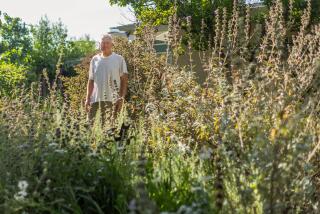Goji berry: Plant your own backyard superfruit
- Share via
Michelle Wong tried to hold back the tears after learning that her landlady had ripped out the goji berry planted in the backyard of her apartment in Koreatown. The shrub was head-high and starting to put out little purple and white flowers where the fruit would appear in summer.
“A lot of people try to grow it, but it’s not that easy,” she said, looking at the remains of the plant. She tried to pluck a few cuttings, in hopes of starting new plants in a place that was more protected.
The loss was particularly painful for Wong because she had been using her harvest in her Chinese medicine studies. The bulk of the world’s goji harvest comes from China, where it has been cultivated for thousands of years and is a staple in traditional medicine.
Goji (Lycium barbarum), a native of the Himalayan valleys of Tibet, has come to be known as wolfberry to some in the West. It was one of the first so-called superfruits, nutritionally dense and loaded with antioxidants. Goji fans hoped the fruit would reduce the threat of macular degeneration and cancer, among other things.
The berries taste sweet and sour, with a distinct metallic aftertaste from the seeds. The bitterness fades when the fruit is dried. In some countries, the leaves are eaten as a potherb, and the bark can be used in teas and infusions.
In the garden, goji likes a high-pH soil, unlike most berries, and they are drought-tolerant when established. They will grow in containers and can handle sun, but they will not be as tall or productive as those in the ground. Goji is a member of the nightshade family (like tomatoes and potatoes), and if left unpruned the plant will get more than 10 feet high, drooping like a weeping willow.
Fruit comes the second year and increases with pruning because berries form on the new growth. Birds adore the fire-engine-red berries and can strip a harvest in minutes.
The plants can be started from seed, easily found online, or from cuttings. Older plants are sometimes available from backyard growers on Craigslist. Burkhard Nurseries in Pasadena carries the plant, and many independent nurseries are happy to special-order plants for you.
The Global Garden, our series looking at multicultural L.A. through the lens of its landscapes, appears here on Tuesdays. We’ve indexed past installments for easy perusal.
For easy way to follow the L.A. scene, bookmark L.A. at Home and join us on Facebook, Twitter and Pinterest.


